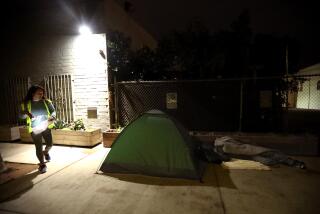Editorial: Three things you think you ‘know’ about homelessness in L.A. that aren’t true
To our dismay, we in Los Angeles have become increasingly familiar with homelessness. But some of the things we “know” about the phenomenon are simply untrue. Dealing with the problem requires knowing the facts and dismissing the myths.
It also requires understanding why those myths persist.
Begin with the falsehood that most homeless people come from out of town, drifting here from colder climates or meaner streets in order to live a life of relative ease on L.A. sidewalks and freeway medians.
Not true. The official counts and companion studies of L.A.’s growing homeless population have consistently shown that most homeless people have lived in Los Angeles for at least 10 years. These are our longtime neighbors who were priced out of their apartments by rents that are rising faster than their incomes, or who were struck by some crisis that rendered them unable to keep a permanent roof over their heads. It may have been a job layoff, a divorce, a cataclysmic and costly health breakdown, an addiction.
Homeless people do not flock to L.A. for the sunshine.
The proportion of homeless in L.A. who are in fact relatively new arrivals pretty much tracks with the numbers in other big cities around the nation. Homeless people do not flock to L.A. for the sunshine.
But there are two points about supposedly newly arrived homeless that require attention. One has to do with homeless youth. Los Angeles, particularly Hollywood, has long been a destination for young people who feel shunned or mistreated by their families and leave their homes in other parts of the nation. The latest homeless count showed a troubling jump in youth homelessness, including kids from out of town. Deeper study is required to understand and respond to this phenomenon.
The second point is that some people are coming to L.A. from other parts of Southern California. As The Times recently reported, some L.A. officials are accusing neighboring municipalities of pushing their own homeless populations across city limits, dumping their problems on Los Angeles.
This is an old problem. More than a decade ago, the county’s first comprehensive response to homelessness completely fell apart because cities like West Covina and Santa Clarita would not participate and instead encouraged their homeless to go to L.A. Los Angeles itself has had a profoundly inadequate and untimely response to homelessness, but some neighboring cities have been even more irresponsible and must be held accountable.
Another homelessness myth is that most people are on the street because they are mentally ill. Again, not true — although it’s easy to see why the misunderstanding persists.
Counts and studies consistently find that between a quarter and a third of homeless people are seriously mentally ill or have serious substance abuse problems. But substance abusers and the mentally ill are the most visible face of homelessness because their behavior draws the most attention. And mental illness is more prevalent among people living on the street — and in public view — than among their homeless counterparts who are couch-surfing or living in cars or shelters.
The nation broke its promise to provide community-based care and treatment for the mentally ill following the closure of state mental hospitals beginning in the 1970s. It’s a promise that ultimately society must keep, and for which it must pay.
Enter the Fray: First takes on the news of the minute »
If we were to house all seriously mentally ill homeless people in Los Angeles (and we should), homelessness would immediately become less evident. But of the more than 100,000 people in the county who were homeless at some point last year, two-thirds were not dealing with serious mental health problems or addiction problems, but fell into homelessness because of the widening gap between wages and housing costs.
Another myth: L.A. isn’t doing anything about the problem. Also not true. The city and county housed more than 20,000 last year, including people who had fallen on economic hard times and many who could not care for themselves because of mental or physical health problems.
But it’s clearly not enough. As people were lifted out of homelessness, more fell in. The net increase was about 17 per day.
It is exasperating, and it leaves the region to wonder whether the proper next step is to double down on current solutions, or somehow change course.
Follow the Opinion section on Twitter @latimesopinion and Facebook
More to Read
A cure for the common opinion
Get thought-provoking perspectives with our weekly newsletter.
You may occasionally receive promotional content from the Los Angeles Times.










